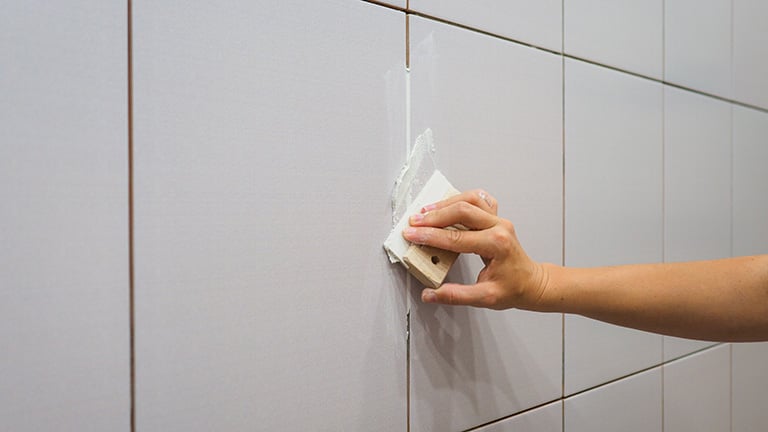
Remodeling your bathroom can add significant value to your home. Your bathroom remodel cost in Columbus, OH will depend on size, fixtures, materials, labor, and other factors.
Tell your cracked grout to get out


Whether it’s on a tile floor, in a shower, or along a backsplash, cracked grout just isn’t a good look. Aesthetics aside, damaged grout can loosen tiles, promote mold growth, and cause structural problems with your walls or floors, so it’s important to address it before it’s too late. However, you don’t always have to hire a professional for this job. Instead, you can learn how to fix cracked grout on your own.

First, put on your safety glasses, dust mask, gloves, and hearing protection. If the damaged grout is on the floor, start by sweeping and vacuuming the area. Then, you can clean the grout with warm water and a grout brush.
Alternatively, if your grout is sealed, you can mix warm water and white vinegar in a spray bottle (using a 1-to-1 ratio) and apply it to the grout. After five minutes, scrub it with a grout brush.
To remove damaged grout, start by using your hands to pull out any cracked, chipped, or crumbling grout that’s loose and easy to remove.
Next, use a grout saw to break up the rest of the damaged grout that you couldn't remove by hand. Work slowly and carefully so you don’t chip the tiles. When the grout is loose enough, pull it out with your hands.
If you’re only replacing some of your grout, it’s important to find a grout color that matches the shade of your current grout. Otherwise, the new grout won’t blend in with the old stuff.
To do this, take a piece of your old grout to a home improvement store and ask an employee to help you find a similar shade.
Use a shop vac to get rid of any dust and debris from the places where you removed grout. Wipe the area down with a clean damp cloth and let it dry.
When you’re done, check to see if there’s any remaining damaged grout. If so, remove it using the process outlined in steps one and two.

If you purchased premixed grout, you can skip this step. But if you bought a mixable version, measure out the right amount of water according to the manufacturer’s instructions. Add it into a bucket, mix in the grout powder, and stir it with a trowel.

Scoop grout onto your rubber grout float. Hold the float at a 45-degree angle and move it over the joints, using sweeping motions to apply the grout evenly. Work in small sections and avoid applying too much grout at once.
Move the float diagonally over the tiles to remove excess grout. This helps create a smooth layer, which is especially important if you’re regrouting floor tile. Otherwise, the uneven grout could create a tripping hazard.

Let the grout sit for 15 to 30 minutes, then wipe the surface of the tiles with a damp grout sponge to remove excess grout. Try not to pull any grout out of the joints, and rinse the sponge often to keep it clean.
Let the grout dry completely. Depending on the type you’re using, it can take between 24 and 72 hours for grout to dry.
When the grout is dry, you might notice a slight haze on the tiles. To remove grout haze, wipe the tiles with a damp cloth and then polish them with a dry cloth.

Sealing grout can help prevent future cracks and protect your grout against water damage, mold, and grime. To seal your grout, start by combining 1/4 cup of vinegar and 8 ounces of water in a spray bottle. Then, apply it to the grout, wipe it down with a cloth, and let it dry completely.
Use a paintbrush or sponge to apply a thin coat of sealer to the new grout. Let it dry for about an hour before applying a second coat.
Repairing cracked grout isn’t necessarily difficult, but it does require a number of tools and supplies that you might not have on hand—like a grout saw, trowel, and grout float. It’s also a messy project that can be quite time-consuming for an inexperienced DIYer.
Coarse scrubbers such as steel wool and rough scouring pads should never be used on grout. They often scrape away a layer of grout in the process. Instead, use a stone-safe sponge or nylon bristle brush to clean your grout effectively and safely.
If you hire a professional for this project, your exact costs will depend on the amount of grout you need fixed and labor prices in your area. On average, though, local grout repair pros charge $250 to $1,000 to regrout 100 square feet of tile.
Very professional, polite and helpful. I would recommend him!
Raven and crew does absolutely fantastic job. They are very professional if any concerns were to occur with any of her work she always took responsibility and finished out with a great job. I have worked with her business for a year and have always been satisfied. Very trusted business and...
I had Ace Fireplace Services install custom chimney caps for my home, and the results are stunning. They fit like a glove and have added a touch of sophistication to my chimney. I can't recommend their services enough.
Custom Paint Jobs LLC turned our outdated bathroom into a modern masterpiece.
Very professional and efficient with work. Answered each question I had with great knowledge and an informative response. Will be working with them again.
Window Depot did an amazing job on my deck. I wasnt sure what I wanted to do, but their composite decking was affordable and will last a long time. I am excited to have family over, and I am no longer embarrassed by my backyard. Jeff and the ground crew were polite, respectful, and caring for...
Great tree company, very professional and honest. Glad we found them, they had the best pricing
Maple Tree Service should serve as a mentor for other business! Customer service was superior and beyond expectation. Response to request was prompt. The representative was very courteous and proud of the company. Quote was given during initial visit and work date established. A follow up...
Eugene returned my call within minutes and was able to complete the job within a couple of days. Friendly and professional, and I feel his prices are reasonable.
We used Unique Hardwood Floor LLC three years ago to work on the floors of a 70 year old home that needed a great deal of work. Some floors needed repairs, some were replaced and others just needed to be refinished. It was a complicated job as they needed to blend the old and the new to...
From average costs to expert advice, get all the answers you need to get your job done.

Remodeling your bathroom can add significant value to your home. Your bathroom remodel cost in Columbus, OH will depend on size, fixtures, materials, labor, and other factors.

Sink installation costs depend on the type of sink, the material, and the labor. This guide can help you budget for your project—from pedestal to farmhouse.

If your bathroom needs sprucing up, a new vanity will make a big difference. Vanity installation costs depend on the size and type of the countertops and fixtures you choose.

An updated bathtub can give a bathroom a whole new look. Find out how much it costs to replace a bathtub in Tampa, FL, including prices by type and labor costs.

An updated bathtub can give a bathroom a whole new look. Find out how much it costs to replace a bathtub in Seattle, WA, including prices by type and labor costs.

Replacing or installing an attic ladder provides a safe way to access your attic. Learn what factors affect attic ladder installation cost to help you budget.